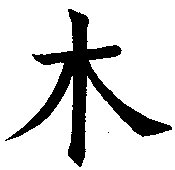2. My confidence lead me to further speculations: 'Winter' has the short ends of the staff indented meaning less sun. The man in 'winter' has a 'barren' Y-shaped hand and his elbow ornament in not complete (at spring equinox there will still remain three months to summer solstice). The man in 'summer' has a 'growing' arm and no incomplete elbow ornament ... When the staff has hatchmarks across it, e.g. (Ab2-38):
it probably means a time when sun is below the horizon, and the short ends of henua are, significantly, then never drawn indented (as in 'winter', cfr above) ... There is a double meaning in henua, not only a period of time but also a connection with light. Henua without hatchmarks means a period of light, henua with hatchmarks a period of darkness. There are no henua in the Mamari calendar for the moon, because the 'land of the moon' is the night. Instead, for a period of night the marama glyph type was used. Calendars involving sun and light use henua (or tapa mea.as in the 'calendar' for the daytime). In the Japanese language yellow is 'kiiro' (ki-iro = tree-colour) and 'tree' is written with the Chinese character showing a tree:
The four examples at right are early variants (ref. Lindqvist). The wood of a tree is yellow and the sun is yellow, therefore the stem of a tree could be used as a symbol for the sun and - more precisely used - as the path of the sun. On the other hand, the Chinese had also another character derived from the picture of a tree, and this they used for the colour red (aka in Japanese):
In the early examples of this character the stem of the tree is marked with a dot (middle) or a horizontal line (right). The Chinese used the stem of certain trees to make red colour pigment. Red or yellow - both colours are like the sun. On Easter Island they preferred to use the hard reddish wood from toromiro for all kinds of wood work, like houses, canoes and sculptures. This kind of wood was in ancient times sacred. To illustrate the path of the sun the stem of a tree was used. That is the origin of the picture behind the henua glyph type ... |


